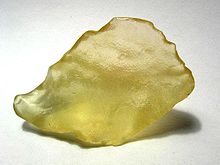Impact glass

As Impaktglas is called a natural glass , the ( "on impact impact ") of a large meteorite is formed. The impact melts rock at the location of the impact. This melt then solidifies to form a natural glass.
Impact glasses are known from many earthly meteorite craters , where they are found irregularly distributed in the respective crater or in its immediate vicinity. In impact glasses, traces of the impactor and inclusions of high pressure minerals such as coesite can often be detected. This is how they differ from tektites : These glasses, which are also formed when large meteorites hit, are thrown up to a few hundred kilometers from the site of the impact, are largely free of inclusions, and could only be detected in a few craters.
Diaplectic glasses can also be formed in the event of a meteorite impact . In contrast to the impact glasses, however, these are not created by melting the host rock, but by the action of the shock wave emanating from the impact.
Well-known representatives of the impact glasses are the Libyan desert glass or the glass bombs called "Flädle", which are stored in the suevite of the Nördlinger Ries .
literature
- Roland Vinx: Rock determination in the field . Munich (Elsevier) 2005 ISBN 3-8274-1513-6
- Johannes Baier: On the origin and importance of the Ries ejection products for the impact mechanism. In: Annual reports and communications from the Upper Rhine Geological Association. 91, 2009, pp. 9-29, doi : 10.1127 / jmogv / 91/2009/9 .
